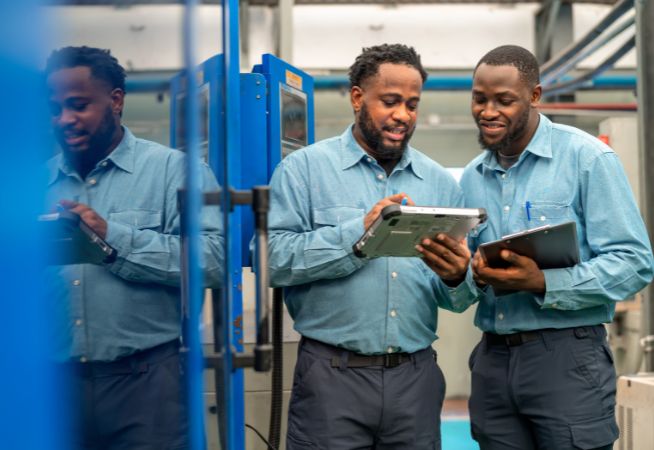September 7, 2023
3 Min. Read

In the fast-paced world of restaurants, continuous learning is vital for success. Whether you’re a small local cafe or a sprawling restaurant chain, keeping your teams engaged and motivated to learn is key to delivering exceptional customer experiences and maintaining a competitive edge. But what does it take to create an environment where your employees are excited about their restaurant training?
While the videos, branding, and buttons are all essential parts of a successful training program, it’s all for nothing if employees aren’t interested in learning. In a recent webinar—Top Training Secrets to Engaging Learners—our Learning and Talent Development Platform Evangelist David Wentworth sat down with learning and development (L&D) leaders from the restaurant industry to discuss the importance of engaging restaurant learners before they click on a piece of content. Let’s explore some strategies our panel mentioned during the webinar.
Leverage the Right Platform
The right workplace learning platform can make or break a company’s L&D goals. When it comes to learner engagement, there is a lot L&D leaders can do to get their teams excited about learning before they begin a course.
It’s critical to offer a digital learning environment that learners are excited to use from their first experience with the interface. The platform should be simple, intuitive, and feel more like a fun activity than a tedious part of the job. You don’t want to frustrate your learners before they even make an account—getting started with training should be as seamless as possible through the right integrations with HR technology stacks, options like single-sign on (SSO), and mobile-responsive user interfaces.
Stu Ackerman, Senior Manager of Multimedia Solutions and Learning Technologies at The Cheesecake Factory, provided insights into what works for their organization. “For us, the whole idea is to create a perfect environment for our guests. And if we‘re not providing a great environment for the people working here, it won’t translate into an exceptional guest experience. We want our team members to enjoy learning, so we try to inject fun into it,” says Stu.
It’s also important to empower the people who are delivering the training. “We make sure our training managers and facilitators have the technology and resources they need to conduct successful training sessions,” shares Jennifer Johnston, Operations Training Manager at Red Lobster. “At the end of the day, it’s about ensuring we’ve checked all the boxes and taken everyone’s needs into account, from our L&D admins to our facilitators to the learners,” she continues.
Build a Culture of Continuous Learning
Restaurants have large teams. For companies with many locations, employees at one restaurant might never interact with those at another. A corporate training program available to all employees, regardless of their roles or locations, bridges the gap between different teams and unites everyone towards common company goals.
Furthermore, learning isn’t something that should only apply to new hires. All team members at every level of the organization should have their own learning goals and actively participate in the company’s training programs.
“Engage your senior leaders! They should be the driving force behind your learning initiatives,” shares Rosa Espinal-Perry—Human Resources Manager at CareerSource Central Florida—which provides on-the-job training to prepare new hires for their work environments. “Executives need to be aware of your communication plans around specific training programs and should champion them throughout the company. Senior leaders should have learning objectives of their own that help them build the skills they need to continue growing the business, and they should set the example for ongoing professional development throughout their careers,” she continues.
Turn Training Into a Game
Communicating the importance of learning is necessary, but sometimes it isn’t enough. At restaurants with hundreds or even thousands of employees, L&D professionals need to get creative to convince people to dedicate time to training in addition to their daily responsibilities.
“Technology is great for some things, but with up to 300 employees at any Cheesecake Factory location, we must be practical. In-person training days for new menu rollouts are important to our L&D initiatives. We get everyone in the restaurant together, assign everyone to a team, have them wear different costumes, and ask them to get involved in the fun of the training. They get to taste the food, interact with each other face-to-face, and participate in a healthy competition that motivates them to learn”, shares Stu.
Gamifying the learning experience gets everyone involved and connected. It breaks down the silos between departments and locations and brings people together as one community.
Tie Training to Performance
Communicating the business goals around each curriculum is crucial to convince employees to participate in training. “What is the business reason for that compliance course or workplace safety initiative? Share it with employees. Showing restaurant learners how their own training activity impacts overall business performance emphasizes the importance of their roles in driving the business forward” says Stu.
Restaurants can also connect training to individual performance goals to encourage employees to participate. At CareerSource Florida, Rosa and her team divide training into courses that are mandatory for compliance and those that are supplementary. “We reward employees who complete more courses as part of their annual performance reviews. We don’t place as much emphasis on the content itself—they can take whichever courses they like. We want to see that our people are continuously learning. That’s what really matters,” she shares.
Offer Training for Career Advancement
Restaurant employees comprise about 10% of the U.S. workforce, making restaurant jobs vital to many people’s careers. Whether or not they choose to continue working in food service, restaurants should offer every employee the opportunity to develop professional skills that apply to any job.
“In many instances, we’re training people so they can advance in their careers. Explaining that a certain training program is associated with a particular career path motivates employees to engage with the learning resources available” shares Stu. Connecting specific training programs with advanced roles within the company demonstrates to employees that there is room for growth within the organization.
Employees must also have the bandwidth to take advantage of available training resources. “We give our people time for training. Every Friday, we encourage them to take a few hours to engage with learning content for their own professional development”, shares Rosa.
Watch the Webinar Replay
Effective training in the restaurant industry goes beyond just delivering content. It’s about creating an engaging learning environment, infusing fun into learning, linking training to performance, building a cohesive culture, and offering pathways to career advancement. By implementing these strategies, you can create a thriving learning ecosystem that benefits your employees and contributes to the long-term success of your restaurant business.
Interested in learning more about how learning can help your restaurant business thrive? Check out a replay of the entire webinar here.


